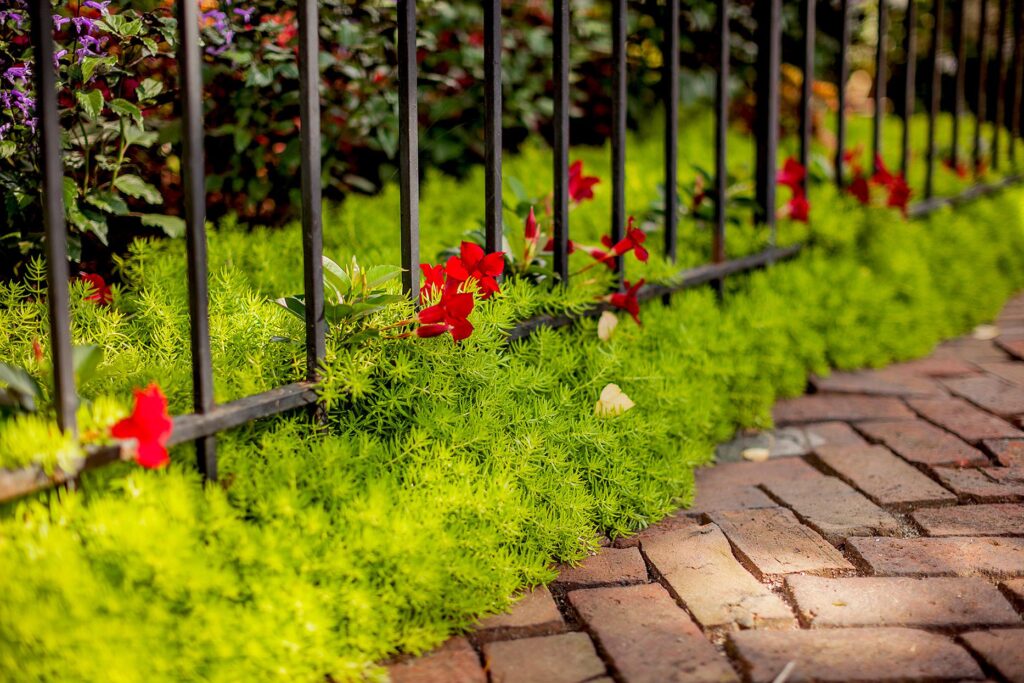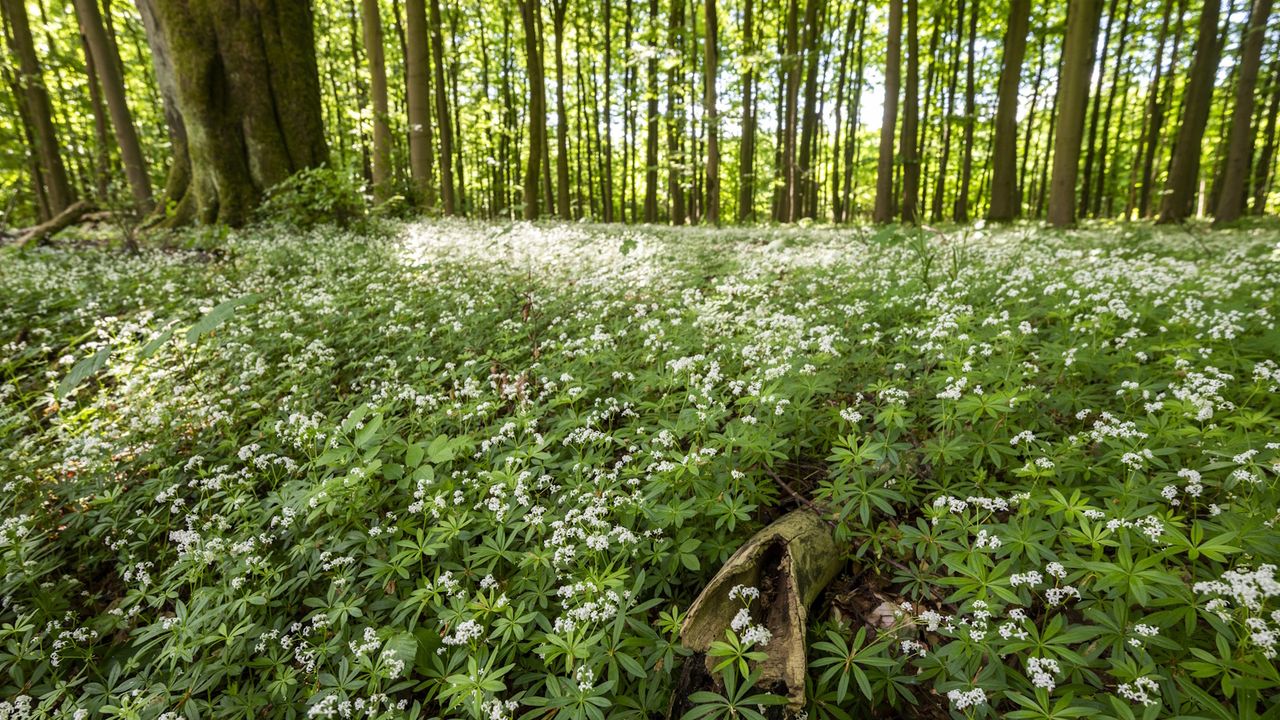When it comes to landscaping and gardening, one of the most challenging areas to work with is full shade. Whether it’s under dense tree canopies, along north-facing walls, or in the shadow of buildings, these spots often struggle to support plant life. However, with the right selection of flowering ground covers, you can transform these barren areas into lush, vibrant spaces teeming with color and life. Ground covers not only add aesthetic appeal but also help suppress weeds, prevent soil erosion, and retain moisture. In this article, we’ll explore the 10 best flowering ground covers for full shade, offering you a variety of options to suit your gardening needs.
1. Hosta (Hosta spp.)
Overview:
Hostas are a classic choice for shaded areas, known for their lush foliage and delicate flowers. While they are primarily grown for their leaves, hostas also produce beautiful, bell-shaped flowers in shades of white, lavender, and purple during the summer months.
Growing Conditions:
Hostas thrive in full to partial shade and prefer moist, well-drained soil rich in organic matter. They are hardy in USDA zones 3-9.
Care Tips:
- Water regularly to keep the soil consistently moist.
- Mulch around the plants to retain moisture and regulate soil temperature.
- Divide clumps every 3-4 years to prevent overcrowding.
Design Tips:
Hostas are versatile and can be used as a ground cover under trees, along pathways, or in shaded garden beds. Pair them with ferns and astilbes for a textured, layered look.
2. Lily of the Valley (Convallaria majalis)
Overview:
Lily of the Valley is a charming, low-growing perennial that produces fragrant, bell-shaped white flowers in the spring. Its dense, spreading habit makes it an excellent ground cover for shaded areas.
Growing Conditions:
This plant prefers full to partial shade and thrives in moist, well-drained soil. It is hardy in USDA zones 2-7.
Care Tips:
- Keep the soil consistently moist, especially during dry spells.
- Apply a layer of mulch to help retain moisture and suppress weeds.
- Be cautious, as Lily of the Valley can be invasive in some areas.
Design Tips:
Lily of the Valley is perfect for creating a carpet of green in shaded woodland gardens. Its sweet fragrance makes it a lovely addition to shaded walkways and borders.
3. Bleeding Heart (Dicentra spectabilis)
Overview:
Bleeding Heart is a shade-loving perennial known for its unique, heart-shaped pink or white flowers that dangle from arching stems. It blooms in the spring and early summer, adding a touch of whimsy to shaded gardens.
Growing Conditions:
Bleeding Heart prefers partial to full shade and thrives in rich, moist, well-drained soil. It is hardy in USDA zones 3-9.
Care Tips:
- Water regularly to keep the soil moist, especially during dry periods.
- Apply a balanced fertilizer in the spring to promote healthy growth.
- Mulch around the plants to retain moisture and regulate soil temperature.
Design Tips:
Bleeding Heart is an excellent choice for shaded borders, woodland gardens, and underplanting beneath trees. Pair it with hostas and ferns for a lush, layered effect.
4. Foamflower (Tiarella cordifolia)
Overview:
Foamflower is a native North American perennial that produces delicate, foam-like spikes of white or pink flowers in the spring. Its heart-shaped leaves add texture and interest to shaded areas.
Growing Conditions:
Foamflower thrives in full to partial shade and prefers moist, well-drained soil rich in organic matter. It is hardy in USDA zones 4-9.
Care Tips:
- Water regularly to keep the soil consistently moist.
- Apply a layer of mulch to help retain moisture and suppress weeds.
- Divide clumps every 2-3 years to prevent overcrowding.
Design Tips:
Foamflower is ideal for shaded rock gardens, woodland gardens, and as a ground cover under trees. Its delicate flowers and attractive foliage make it a lovely addition to any shaded garden.
5. Sweet Woodruff (Galium odoratum)
Overview:
Sweet Woodruff is a low-growing perennial that produces tiny, star-shaped white flowers in the spring. Its fragrant, whorled leaves add texture and interest to shaded areas.
Growing Conditions:
Sweet Woodruff thrives in full to partial shade and prefers moist, well-drained soil. It is hardy in USDA zones 4-8.
Care Tips:
- Water regularly to keep the soil consistently moist.
- Apply a layer of mulch to help retain moisture and suppress weeds.
- Be cautious, as Sweet Woodruff can be invasive in some areas.
Design Tips:
Sweet Woodruff is perfect for creating a fragrant, green carpet in shaded woodland gardens. Its delicate flowers and attractive foliage make it a lovely addition to shaded walkways and borders.
6. Japanese Painted Fern (Athyrium niponicum ‘Pictum’)
Overview:
While not a flowering plant, the Japanese Painted Fern is a stunning ground cover for shaded areas, known for its silvery-green fronds with purple accents. It adds a touch of elegance and texture to shaded gardens.
Growing Conditions:
Japanese Painted Fern thrives in full to partial shade and prefers moist, well-drained soil rich in organic matter. It is hardy in USDA zones 4-9.
Care Tips:
- Water regularly to keep the soil consistently moist.
- Apply a layer of mulch to help retain moisture and regulate soil temperature.
- Divide clumps every 3-4 years to prevent overcrowding.
Design Tips:
Japanese Painted Fern is ideal for shaded borders, woodland gardens, and as a ground cover under trees. Pair it with hostas and astilbes for a textured, layered look.
7. Lungwort (Pulmonaria spp.)
Overview:
Lungwort is a shade-loving perennial known for its spotted foliage and clusters of tubular flowers that change color from pink to blue as they mature. It blooms in the spring, adding a splash of color to shaded areas.
Growing Conditions:
Lungwort thrives in full to partial shade and prefers moist, well-drained soil rich in organic matter. It is hardy in USDA zones 3-8.
Care Tips:
- Water regularly to keep the soil consistently moist.
- Apply a balanced fertilizer in the spring to promote healthy growth.
- Mulch around the plants to retain moisture and regulate soil temperature.
Design Tips:
Lungwort is an excellent choice for shaded borders, woodland gardens, and underplanting beneath trees. Its colorful flowers and attractive foliage make it a lovely addition to any shaded garden.
8. Coral Bells (Heuchera spp.)
Overview:
Coral Bells are versatile perennials known for their colorful foliage and delicate, bell-shaped flowers that bloom in the spring and summer. They come in a wide range of colors, from deep burgundy to lime green, making them a popular choice for shaded gardens.
Growing Conditions:
Coral Bells thrive in full to partial shade and prefer moist, well-drained soil rich in organic matter. They are hardy in USDA zones 4-9.
Care Tips:
- Water regularly to keep the soil consistently moist.
- Apply a balanced fertilizer in the spring to promote healthy growth.
- Mulch around the plants to retain moisture and regulate soil temperature.
Design Tips:
Coral Bells are ideal for shaded borders, rock gardens, and as a ground cover under trees. Their colorful foliage and delicate flowers make them a lovely addition to any shaded garden.
9. Wild Ginger (Asarum canadense)
Overview:
Wild Ginger is a native North American perennial known for its heart-shaped leaves and unique, bell-shaped flowers that hide beneath the foliage. It forms a dense ground cover in shaded areas.
Growing Conditions:
Wild Ginger thrives in full to partial shade and prefers moist, well-drained soil rich in organic matter. It is hardy in USDA zones 4-7.
Care Tips:
- Water regularly to keep the soil consistently moist.
- Apply a layer of mulch to help retain moisture and suppress weeds.
- Divide clumps every 3-4 years to prevent overcrowding.
Design Tips:
Wild Ginger is perfect for creating a lush, green carpet in shaded woodland gardens. Its unique flowers and attractive foliage make it a lovely addition to shaded walkways and borders.

10. Barrenwort (Epimedium spp.)
Overview:
Barrenwort, also known as Bishop’s Hat, is a shade-loving perennial known for its delicate, spider-like flowers and heart-shaped leaves. It blooms in the spring, adding a touch of elegance to shaded areas.
Growing Conditions:
Barrenwort thrives in full to partial shade and prefers moist, well-drained soil rich in organic matter. It is hardy in USDA zones 5-9.
Care Tips:
- Water regularly to keep the soil consistently moist.
- Apply a balanced fertilizer in the spring to promote healthy growth.
- Mulch around the plants to retain moisture and regulate soil temperature.
Design Tips:
Barrenwort is ideal for shaded borders, woodland gardens, and as a ground cover under trees. Its delicate flowers and attractive foliage make it a lovely addition to any shaded garden.
Conclusion
Transforming shaded areas in your garden into lush, vibrant spaces is entirely possible with the right selection of flowering ground covers. From the delicate blooms of Lily of the Valley to the colorful foliage of Coral Bells, there’s a ground cover to suit every shaded garden. By choosing plants that thrive in full shade and providing them with the proper care, you can create a beautiful, low-maintenance garden that will be the envy of your neighbors. So, don’t let those shady spots go to waste—embrace the challenge and turn them into stunning garden features with these 10 best flowering ground covers for full shade.
-
15 Easy Breakfast Ideas That Save Time
Spread the love15 Easy Breakfast Ideas That Save Time In today’s fast-paced world, mornings can be chaotic — between getting ready for work, managing kids, and planning the day ahead, breakfast often takes a back seat. But as nutritionists always say, breakfast is the most important meal of the day. It fuels your body, jump-starts…
-
20-Minute Air Fryer Recipes Everyone’s Loving
Spread the love20-Minute Air Fryer Recipes Everyone’s Loving In today’s fast-paced world, we all want quick, healthy, and delicious meals without spending hours in the kitchen. That’s exactly where the air fryer comes in — a game-changing kitchen gadget that’s making cooking easier, faster, and healthier than ever before. From crispy chicken wings to perfectly…

